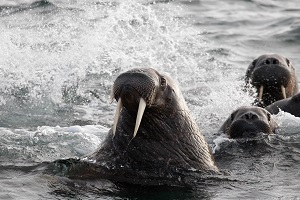Please activate JavaScript in your browser to use all interface options.
Rosneft Contributes in Research and Conservation of Walrus
24 November 2021
World Walrus Day is celebrated on November 24 to raise public awareness of the conservation of the largest pinniped population living in the Northern Hemisphere. As part of a multi-year programme to study Arctic ecosystems, Rosneft Oil Company is conducting expedition research on walruses together with the Severtsov Institute of Ecology and Evolution of the Russian Academy of Sciences and the Centre for Marine Research of the Lomonosov Moscow State University.
Environmental protection is one of the key priorities for Rosneft Oil Company in its operations. The Company undertakes a number of initiatives aimed to preserve and restore natural resources, as well as to study biodiversity. The Atlantic walrus subspecies is listed in the Red Book of Russia and serves as a bioindicator of Arctic marine ecosystems. The Company considers the conservation of these animals and their habitats to be one of its environmental and conservation missions.
Rosneft has been carrying out population studies on the Atlantic walrus subspecies since 2015. The works were conducted at the state nature reserve Nenetsky (in 2015 and 2019), in the waters of the Barents, Kara and Laptev Seas. An extensive study of walruses in the Barents Sea was carried out in 2020 and 2021, as part of the national Ecology Project.
With Rosneft’s help, the Franz Josef Land archipelago, the Orange Islands (territory of the Russian Arctic National Park) and Victoria Island were studied for the first time. The scientists mapped known walrus rookeries in detail, described new haulout sites, and conducted a single full-scale census of walruses using unmanned aerial vehicles. The resulting population figure of more than 7,000 animals doubles the previous estimate. The largest aggregation of walruses, over 2,000 animals, was registered on Eva-Liv Island (Franz Josef Land) in 2021. Two field seasons saw a total of 40 islands explored.
Some trivia:
A walrus tusk is up to 1 metre long and weighs up to 5.4 kg. Tusks grow throughout life, but may break and grind away.
Walruses can turn light grey or even pink. Walruses are usually brown in colour, but when immersed in cold water they turn light grey, or pink when exposed to the sun. This is due to their ability to alter the blood supply to their body’s periphery under certain circumstances.
Walruses hardly ever eat fish. Their diet is based on bottom-dwelling bivalve molluscs, as well as gastropod molluscs, polychaetes and bristleworms. A walrus can eat up to 6,000 molluscs a day. However, there are some walruses that prey on seals, especially the babies of ringed seals and harp seals. Those are called kelucha.
Walruses, especially males, can sleep on the water. They have paired air bags without closing valves. The bags inflate under the skin of the neck and allow the walrus to stay upright in the water while sleeping.
Scientists used space technology to locate walrus haulouts by capturing new habitats on satellite images. Data from satellite transmitters placed on walruses during fieldwork have also been used since 2020.
Rosneft
Information Division
November 24, 2021

-315xx70.png)

